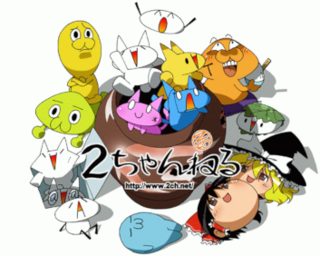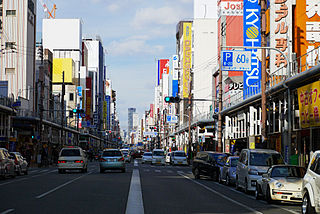 W
WOtaku is a Japanese word that describes people with consuming interests, particularly in anime and manga. Its contemporary use originated with a 1983 essay by Akio Nakamori in Manga Burikko. Otaku may be used as a pejorative with its negativity stemming from a stereotypical view of otaku as social outcasts and the media's reporting on Tsutomu Miyazaki, "The Otaku Murderer", in 1989. According to studies published in 2013, the term has become less negative, and an increasing number of people now identify themselves as otaku, both in Japan and elsewhere. Out of 137,734 teens surveyed in Japan in 2013, 42.2% self-identified as a type of otaku.
 W
W2channel , also known as 2ch, Channel 2, and sometimes retrospectively as 2ch.net, was an anonymous Japanese textboard founded in 1999 by Hiroyuki Nishimura. Described in 2007 as "Japan's most popular online community", the site had a level of influence comparable to that of traditional mass media such as television, radio, and magazines. At the time, the site drew an annual revenue of around ¥100 million, and was the largest of its kind in the world, with around ten million visitors and 2.5 million posts made per day.
 W
WAkihabara is a common name for the area around Akihabara Station in the Chiyoda ward of Tokyo, Japan. Administratively, the area called Akihabara mainly belongs to the Sotokanda (外神田) and Kanda-Sakumachō districts in Chiyoda. There exists an administrative district called Akihabara in the Taitō ward further north of Akihabara Station, but it is not the place people generally refer to as Akihabara.
 W
WAkishibu-kei is a loosely defined trend from the 2000s that involved an increase of Shibuya-kei influence in anime soundtracks. The term is a portmanteau of "Shibuya-kei" and "Akiba-kei". Both were 1990s cultural movements associated with musical and otaku interests, respectively, and Akishibu-kei was thought to have represented a merging of the two.
 W
WComic Frontier, also widely known as Comifuro is a dōjinshi convention held bi-annually in Jakarta, Indonesia.
 W
WComic Market , more commonly known as Comiket and sometimes Comike , is a biannual dōjinshi fair in Tokyo, Japan. It is typically held at Tokyo Big Sight in August and December.
 W
WCosplay, a portmanteau of "costume play", is an activity and performance art in which participants called cosplayers wear costumes and fashion accessories to represent a specific character. Cosplayers often interact to create a subculture, and a broader use of the term "cosplay" applies to any costumed role-playing in venues apart from the stage. Any entity that lends itself to dramatic interpretation may be taken up as a subject. Favorite sources include anime, cartoons, comic books, manga, television series, and video games. The term is composed of the two aforementioned counterparts - costume and role play.
 W
WA dakimakura is a type of large pillow from Japan. The word is often translated to English as body pillow. In Japan, dakimakura are similar to Western orthopedic body pillows, and are commonly used by Japanese youth as "security objects".
 W
WA denpa song (電波ソング) is a type of Japanese music that is intentionally strange and catchy. Common features of denpa songs include intentionally off-key vocals, nonsensical lyrics and an over-the-top tune. Denpa music has grown into a subculture within Japan, forming a significant aspect of otaku culture and has large numbers of dōjin circles and music artists dedicated to denpa music. Denpa is not a specific genre in itself, but rather an umbrella term for various kinds of music.
 W
WDvach, also known as 2ch, is the largest Russian anonymous imageboard. It originally began in 2006 and was shut down in 2009. It was succeeded by many copies, one of which became more popular than the original. It is currently known as 2ch.hk and run by Nariman Namazov, nicknamed Abu. After a major DDoS-attack in 2016, it has been hosted by a state-affiliated company, the Mail.Ru Group, leading many users to believe that it was sold to the company for an undisclosed sum.
 W
WGundam is a Japanese military fiction media franchise/media mix. Created by Yoshiyuki Tomino and Sunrise, the franchise features giant robots, or mecha, with the name "Gundam". The franchise began on April 7, 1979 with Mobile Suit Gundam, a TV series that defined the "real robot" mecha anime genre by featuring giant robots called mobile suits in a militaristic setting. The popularity of the series and its merchandise spawned a franchise that includes 50 TV series, films and OVAs as well as manga, novels and video games, along with a whole industry of plastic model kits known as Gunpla which makes up 90 percent of the Japanese character plastic-model market.
 W
WThe Japanese Wikipedia is the Japanese-language edition of Wikipedia, a free, open-source online encyclopedia. Started on 11 May 2001, the edition attained the 200,000 article mark in April 2006 and the 500,000 article mark in June 2008. As of November 2021, it has over 1,298,000 articles with 14,932 active contributors, ranking fourth behind the English, Spanish and Russian editions.
 W
WTsutomu Miyazaki was a Japanese serial killer who murdered four young girls in Tokyo and Saitama Prefecture between August 1988 and June 1989. He was termed by the Japanese media as the "Otaku Murderer".
 W
WA model figure is a scale model representing a human, monster or other creature. Human figures may be either a generic figure of a type, a historical personage, or a fictional character.
 W
WTakashi Murakami is a Japanese contemporary artist. He works in fine arts media as well as commercial and is known for blurring the line between high and low arts. He coined the term "superflat," which describes both the aesthetic characteristics of the Japanese artistic tradition and the nature of postwar Japanese culture and society, and is also used for Murakami's artistic style and other Japanese artists he has influenced.
 W
WNipponbashi (日本橋) is a shopping district of Naniwa Ward, Osaka, Japan. The area is centered along Sakaisuji Avenue, extending from the Ebisu-chō Interchange of the Hanshin Expressway in the south, to Nansan-dōri in the north. Known colloquially as "Den-Den Town," Nipponbashi is known for its many shops which specialize in furniture, tools, and "otaku" interests such as electronics, anime, manga, and collectibles. Nipponbashi is often compared to Akihabara Electric Town, its equivalent in Tokyo.
 W
WThe Otaku Encyclopedia is a 2009 encyclopedia written by Patrick Galbraith and published by Kodansha which provides an overview of anime and manga topics, and interviews and profiles of important people in Japanese fandom.
 W
WOtaku Girl is a science fiction novel written by Louis Bulaong and published on June 23, 2021. The story was first posted as a webnovel, becoming noted for its postmodern elements and pop culture references, before being published as a book four months later. It is the sequel to Bulaong's debut novel Escapist Dream.
 W
WOtome Road is a name given to an area of Ikebukuro, Tokyo, Japan that is a major shopping and cultural center for anime and manga aimed at women. The area is sometimes referred to as Fujoshi Street, referencing the name given to fans of yaoi.
 W
WTokusatsu is a Japanese term for live action film or television drama that makes heavy use of special effects. Tokusatsu entertainment often deals with science fiction, fantasy or horror, but films and television shows in other genres can sometimes count as tokusatsu as well. The most popular types of tokusatsu include kaiju monster films such as the Godzilla and Gamera film series; superhero TV serials such as the Kamen Rider and Metal Hero series; and mecha dramas like Giant Robo and Super Robot Red Baron. Some tokusatsu television programs combine several of these subgenres, for example the Ultraman and Super Sentai series.
 W
WA virtual YouTuber or VTuber is an online entertainer who uses a virtual avatar generated using computer graphics and motion capture software or technology. A digital trend that originated in Japan in the mid-2010s, a majority of VTubers are Japanese-speaking YouTubers or live streamers who use anime-inspired avatar designs. By 2020, there were more than 10,000 active VTubers. Despite their name, virtual YouTubers are not exclusive to Youtube but are also on platforms like Niconico, Twitch and Bilibili.
 W
WJapanophilia is the philia of Japanese culture, people and history. In Japanese, the term for Japanophile is "shinnichi" (親日), with "親" equivalent to the English prefix 'pro-' and "日", meaning "Japan". The term was first used as early as the 18th century, switching in scope over time.
 W
WWotagei (ヲタ芸), also known as otagei (オタ芸), refers to a type of dancing and cheering gestures performed by wota, fans of Japanese idol singers, involving jumping, clapping, arm-waving and chanting slogans. Wotagei is performed at concerts, or at events such as anime and manga conventions and meetings of idol fan groups, and it is thought to have developed from the ōendan, organised cheering squads common at sporting events in Japan. Wotagei is particularly associated with fans of Hello! Project and AKB48 idols, as well as fans of anime and game voice actresses (seiyuu), who often perform theme songs for the series in which they appear.